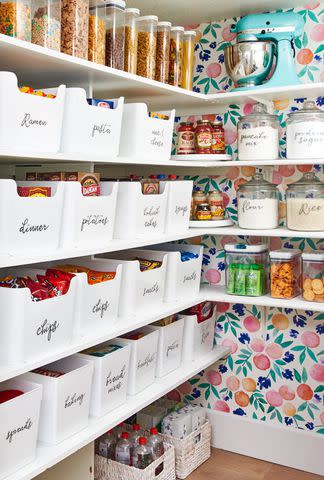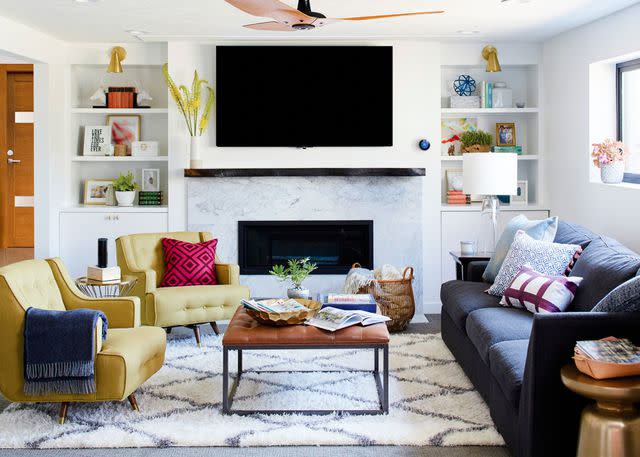Declutter Your Home Fast with These 15-Minute Organizing Tasks
These daily storage tasks make getting organized easy.

You might not be able to clear all the clutter in your home in 15 minutes, but by taking some time to focus on specific tasks, you can get organized little by little. These ideas will show you how to conquer clutter room by room with 15-minute organizing sprints. Schedule time for one or two tasks each day to achieve a tidy home in less time.
Create a Strategy to Declutter Your Home

Declutter your home bit by bit so you can avoid the overwhelming experience of an hours-long decluttering marathon. To get started, choose a room and select one simple task to complete. Set a timer for 15 minutes and get as much done as possible within that time. If you don't finish the project, start the timer over or come back to it later.
Chip Away at Clutter

Identify your biggest clutter issue: magazines and mail, kids' gear, or another type of item. Spend a few minutes tackling this project every day or every few days. As you sort through the accumulated items, determine what can be tossed, recycled, donated, or stored elsewhere. Then sort everything left into categories and bring in organizers to neatly contain the items.
Categorize Pantry Items

Target a category of pantry items that tends to remain chaotic and challenging to access. Focus on a single pantry staple, such as baking supplies, breakfast foods, or snacks, instead of trying to reorganize the entire system. Use bins and baskets to organize similar items, and label your containers, so you know what goes where when you're unloading your next round of groceries.
Create Dining Room Storage

"Undesignated space is the key problem in eating spaces," says professional organizer Lorie Marrero. "Rather than dumping stuff on the table, assign specific places for specific items and create destination stations." If paperwork is the problem, for example, set up a basket or tray sorting system to organize kid's papers, mail, and more. If your kitchen or dining room doubles as an office or homework station, wrangle desk supplies into organizers and stash them in a cabinet.
Reorder Hanging Clothes

Organize the hanging clothes in your closet by types, such as dresses, shirts, and pants, then add hanger tags to keep like garments together. You can also organize clothes by season or purpose, such as "work" or "casual." Consider organizing and labeling by size in a child's closet since they quickly move from baby to toddler and big kid sizes.
Corral Entryway Apparel

Hang hooks on a wall, so every family member has a dedicated spot for jackets, hats, and backpacks to declutter your home's main entrypoint. Make sure to install the hooks low enough to reach, or kids will end up dumping everything on the floor. Dedicate a shelf or two for shoe storage. Positioning a bench near the entryway makes it easier for everyone to slip shoes on and off.
Tidy Workspaces

Zone in on the spot to declutter your home office or workspace where clutter most interferes with your productivity. If it's your main desk drawer, grab a few drawer dividers or trays to organize all those miscellaneous items that pile up. If papers are the problem, sort through as much as you can in 10 to 15 minutes.
If you have more time to commit to the paper pileup, determine a filing strategy before you start sorting, so you know what to do with the papers once they're organized.
Tackle the Junk Drawer
Take a few minutes to sort through the miscellaneous items you've been tossing into a drawer. Start by emptying the contents and determining which items should be stored elsewhere. Then follow the tips in this video to achieve an organized junk drawer.
Separate Bathroom Supplies

Extra bottles of shampoo and other spare toiletries can easily get lost under your bathroom sink. To avoid purchasing more of what you already have, try professional organizer Laura Leist's "shop from home strategy." Store your excess products elsewhere, like in a linen closet or a basket on a shelf, and check your inventory before shopping.
Streamline Spices

Instead of stacking spices in a cabinet where they're difficult to access, label the lids on your spice jars and store them in a drawer or basket. Consider using a desk tray for office supplies to stand everything upright so you can easily read the labels. Use refillable spice jars to avoid the jumbled mess of different sizes of spice containers.
Sort Baking Sheets and Platters

Create a vertical partition in a cabinet with pairs of wooden inserts or spring-loaded curtain rods to keep baking sheets, platters, cutting boards, and trays in line. You can also purchase a cabinet insert to keep items standing at attention. Group items by category, such as pizza pans, muffin tins, and serving platters, so it's easy to find what you need.
Declutter Your Home Entertaining Supplies

Organize small entertaining essentials, like table linens and napkin rings, in shallow drawers near the dining table. If you don't have built-in cabinets in or near the dining room, look for a console table or beverage cart with storage to keep items for setting your table at the ready. Sort them by type or occasion, such as holiday meals or summer parties.
Declutter the Living Room

Set up a "lost and found" system to manage to declutter your home in your living room or family room. Assign each family member their own basket. Toss their items into their basket as you clean, and set up your own rules for what needs to be done with the basket. For instance, decide whether family members need to empty theirs when it's full or if you'll have a once-a-week basket clean-out session.
Lay Out Kids' Clothes

Make it a habit to spend 15 minutes before the start of each week planning kids' outfits. A hanging shelf offers space to tuck in accessories and shoes. You could also label hangers with the days of the week and hang up their outfits for the week.
Rearrange Games and Puzzles

Stacked board games and puzzles are an invitation for crashing piles. Ward off the potential mess with a wire pan rack ($20, Target). If needed, use large rubber bands to keep the boxes closed, then file them vertically. The slots will keep boxes upright and easy to grab on game night.
Store First Aid Supplies

Store first aid supplies in a caddy or tray to keep your closet tidy and make it easy to carry the whole kit anywhere in the house. A utensil tray works well for corraling bandages, ointments, and first aid supplies in different compartments. Clip on file tabs to identify what goes where.
Consolidate Shoe Storage

Streamline your shoe storage near the entryway by stowing off-season shoes elsewhere. Pack shoes one layer deep in a labeled underbed bin ($27, The Container Store), adding dividers if needed to keep pairs in place. Choose a clear container with wheels and a split lid for easy access.
Set Up a Jewelry System

Can't ever find the exact pair of earrings you want? Implement a system that allows you to see everything you have. Organize small earrings in a divided tray, and hang necklaces from a decorative corkboard or small hooks. For a DIY organizing project, dangle larger earrings on a piece of metal screening placed inside a frame.
Simplify Laundry Room Clutter

Laundry rooms tend to gather lots of odds and ends. Set up a series of jars inside a tray and use them to collect pocket finds, clothespins, and mending supplies. Opt for clear glass so you can see what each jar contains. Colorful bins might look nice on a shelf, but they can quickly become overrun with objects, making it hard to find anything.
Organize Papers in the Entryway

Employ mini cubbies near the door for necessary (but infrequently used) papers, such as gift certificates, coupons, and school forms. This ensures paperwork is easy to drop off or grab as you head in or out of the door. You could also personalize cubbies for each family member, so they know where to look each day for permission slips and reminders.